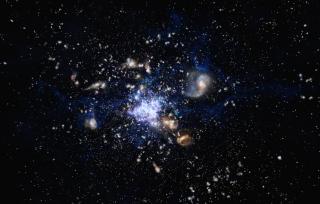Bibcode
Yang, Qian; Shen, Yue; Liu, Xin; Aguena, Michel; Annis, James; Avila, Santiago; Banerji, Manda; Bertin, Emmanuel; Brooks, David; Burke, David; Carnero Rosell, Aurelio; Carrasco Kind, Matias; da Costa, Luiz; De Vicente, Juan; Desai, Shantanu; Diehl, H. Thomas; Doel, Peter; Flaugher, Brenna; Fosalba, Pablo; Frieman, Josh; Garcia-Bellido, Juan; Gerdes, David; Gruen, Daniel; Gruendl, Robert; Gschwend, Julia; Gutierrez, Gaston; Hinton, Samuel; Hollowood, Devon L.; Honscheid, Klaus; Kuropatkin, Nikolay; Maia, Marcio; March, Marisa; Marshall, Jennifer; Martini, Paul; Melchior, Peter; Menanteau, Felipe; Miquel, Ramon; Paz-Chinchon, Francisco; Malagón, Andrés Plazas; Romer, Kathy; Sanchez, Eusebio; Scarpine, Vic; Schubnell, Michael; Serrano, Santiago; Sevilla, Ignacio; Smith, Mathew; Suchyta, Eric; Tarle, Gregory; Varga, Tamas Norbert; Wilkinson, Reese
Bibliographical reference
The Astrophysical Journal
Advertised on:
9
2020
Journal
Citations
45
Refereed citations
40
Description
The size of the dust torus in active galactic nuclei (AGNs) and their high-luminosity counterparts, quasars, can be inferred from the time delay between UV/optical accretion disk continuum variability and the response in the mid-infrared (MIR) torus emission. This dust reverberation mapping (RM) technique has been successfully applied to ∼70 z ≲ 0.3 AGNs and quasars. Here we present first results of our dust RM program for distant quasars covered in the Sloan Digital Sky Survey Stripe 82 region combining ∼20 yr ground-based optical light curves with 10 yr MIR light curves from the WISE satellite. We measure a high-fidelity lag between W1 band (3.4 μm) and g band for 587 quasars over 0.3 ≲ z ≲ 2 ( $\left\langle z\right\rangle \sim 0.8$ ) and two orders of magnitude in quasar luminosity. They tightly follow (intrinsic scatter ∼0.17 dex in lag) the IR lag-luminosity relation observed for z < 0.3 AGNs, revealing a remarkable size-luminosity relation for the dust torus over more than four decades in AGN luminosity, with little dependence on additional quasar properties such as Eddington ratio and variability amplitude. This study motivates further investigations in the utility of dust RM for cosmology and strongly endorses a compelling science case for the combined 10 yr Vera C. Rubin Observatory Legacy Survey of Space and Time (optical) and 5 yr Nancy Grace Roman Space Telescope 2 μm light curves in a deep survey for low-redshift AGN dust RM with much lower luminosities and shorter, measurable IR lags. The compiled optical and MIR light curves for 7384 quasars in our parent sample are made public with this work.
Related projects

Molecular Gas and Dust in Galaxies Across Cosmic Time
Two of the most fundamental questions in astrophysics are the conversion of molecular gas into stars and how this physical process is a function of environments on all scales, ranging from planetary systems, stellar clusters, galaxies to galaxy clusters. The main goal of this internal project is to get insight into the formation and evolution of
Helmut
Dannerbauer